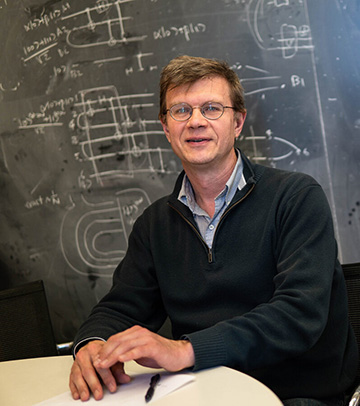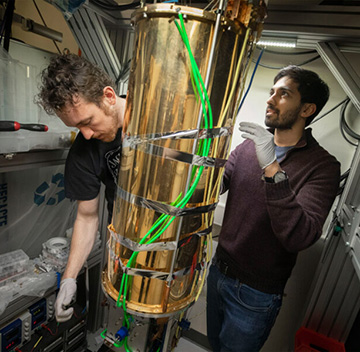
Mikhail Lukin. [Image: Sophie Park/Harvard University]
From ultra-precise sensors to code-breaking computers, scientists tell us that the weird rules governing the quantum realm can lead to very concrete applications. In a keynote talk at the OPN’s Quantum 2.0 Conference on Thursday, OSA Fellow Mikhail Lukin described two quite different quantum systems being investigated by his group at Harvard University, USA, that he says could yield advantages over existing classical technology.
Atomic checkerboard
The first of these systems involves large two-dimensional arrays of atoms excited into Rydberg states. In a Rydberg atom, the outermost valence electron has a very high quantum number and lies far from the nucleus. This in effect inflates such atoms and makes them interact very strongly with their neighbors.
Lukin told his online audience at Quantum 2.0 how he and his colleagues exploit what is known as a “Rydberg blockade”—the impossibility of exciting two neighboring atoms into a Rydberg state when they get too close together. The idea is to laser cool and trap atoms into a 2-D array and then excite them, with the distance between atoms determining the shape of that array.
Working with as many as 200-300 atoms, the Harvard group can create a checkerboard arrangement, filling every other lattice point by having nearest neighbors blockade one another. But by changing the distance between atoms, they can generate all sorts of other configurations, such as star shapes and bands of atoms.
System-level behavior
It is this system-level behavior, explained Lukin, that makes Rydberg atoms ideally suited to quantum simulations that can be used to solve certain optimization problems. He gave the example of working out what is known as the largest independent set for a graph with a certain number of vertices linked by a specific arrangement of edges. In other words, what is the largest subset of vertices that have no links with one another?
An apparently arcane problem, Lukin said that it does in fact have real-world applications—in the design of networks and machine learning. Having arrays of Rydberg atoms, he said, makes it “very easy” to encode the problem, then let the system evolve adiabatically to reveal a given number of excited atoms. Although not yet beyond the limits of classical algorithms, this simulator can deal with graphs of up to 179 nodes, with bigger ones potentially to follow.
Quantum memory and repeaters
“Changing gears,” Lukin then talked about how his group is working to extend the range of secure quantum communications. In particular, he described how diamond-based quantum memory can boost the efficiency of quantum key distribution (QKD) involving Bell-state measurements.
QKD systems have been available commercially for some time but remain the subject of intense research. In particular, secure communications cannot be carried out over more than a few hundred kilometers owing to the absorption and scattering of photons as they travel along optical fiber. Classically, such losses can be overcome using amplifiers. Doing a similar thing with a quantum signal, however, would impair its security.
Lukin explained how the quantum memory can improve QKD and provide a key ingredient for quantum repeaters—devices that in future could allow quantum communications to be extended over arbitrarily long distances.
Alice, Bob, Charlie
One particularly secure form of QKD involves two people, usually nicknamed Alice and Bob, sending photons to a third party (Charlie). Charlie then carries out a Bell-state measurement on the photons, but doesn’t learn the specific quantum states of those particles in the process. This allows Alice and Bob to share correlated pairs of qubits that they can use to create a secret key for encoding and decoding messages.
The scheme only works, though, if the photons from Alice and Bob get to Charlie simultaneously. The idea with the quantum memory is to store the state of the photon that gets there first until the second one arrives.
Silicon–vacancy centers

Harvard grad students David Levonian (left) and Mihir Bhaskar were among those who worked on the Lukin lab’s recently published quantum repeater work. [Image: Kris Snibbe/Harvard file photo]
To create such a quantum memory, Lukin and his team are focusing on so-called silicon–vacancy centers—atom-like defects created when two carbon atoms in a diamond lattice are replaced by a silicon atom and a gap. Such a defect, integrated inside a nanophotonic diamond resonator, yields a solitary spin that can remain in a coherent quantum state for more than two milliseconds when chilled to within a fraction of a degree above absolute zero.
By exploiting this solid-state spin memory, Lukin said that he and his colleagues were able to boost the secret key rate by at least a factor of four compared with direct transmission, for which Bell state measurements can be carried out only when photons from the communicating parties happen to arrive at the same time.
Looking ahead, the Harvard researchers will attempt to carry out a similar feat with light at telecom wavelengths. And at the same time, said Lukin, they hope to make "serious inroads" into the development of quantum repeaters.
